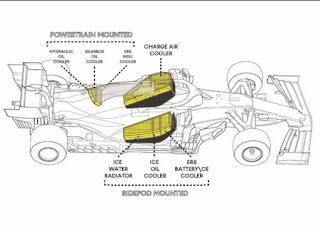Formula 1 cars are built to go at incredible speeds. However, due to the high degree of performance of these vehicles, the components must work exceptionally quickly. These components may be damaged if they are not cooled in a timely manner, although many F1 spectators are unaware of how the cars are cooled.
Formula One cars use both air and water cooling systems. While certain components, such as the engine, use water to cool, others, such as the brakes, use air. Both sorts of systems are utilised to maximise F1 cars' cooling potential while maintaining aerodynamics.
In this article, we'll go over all you need to know about the cooling systems used in Formula One cars. After explaining why engineers chose to use both water- and air-based cooling technologies,We'll talk about how several vital components are cooled in these vehicles using air-based cooling systems.
ARE FORMULA 1 CARS COOLED WITH AIR OR WATER?
Most current automobiles have water-cooled engines and radiators. Water pumps and hoses are utilised in these cooling systems to circulate a water and coolant mixture through the engine. The heat from the engine is transmitted to the coolant before it is cooled in the radiator.
Many F1 enthusiasts have naturally asked how the cooling systems of F1 cars differ from this; do F1 cars employ water-cooling as well, or do they prefer air-cooling? Even long-time F1 fans may be surprised by the answer: the cars use both water and air cooling. While some components, such as the engine, are water-cooled, others, such as the brakes, are just air-cooled.
The cooling systems of Formula One cars are precisely developed to guarantee that the car remains effective while maintaining aerodynamics. After all, F1 cars can accelerate from 0 to 60mph in less than three seconds and are meant to race at speeds of up to 220mph. A dynamic cooling system is required to support this high degree of performance.
Many fans have naturally puzzled why F1 cars have both water- and air-cooling systems rather than just one. Air inlets must be incorporated into F1 cars to facilitate air cooling. However, these outlets effectively counter the vehicle's aerodynamics. The number of required air inlets can be lowered by using water cooling for some components.
Finally, combining water and air to cool F1 cars allows the cars to stay aerodynamic while minimising the chance of vital components seizing during a race. The section that follows will explain how these important parts, such as the engine, brakes, electronics, and more, are cooled!
HOW ARE DIFFERENT COMPONENTS COOLED IN F1 CARS?
Valtteri Bottas set the current Formula One race speed record of 231.4 miles per hour during the 2016 Mexican Grand Prix. Fans can only imagine the heat produced by Bottas' car when he broke this record. With F1 vehicles constantly breaking speed records, many fans have pondered how certain crucial components in F1 cars are cooled.
F1 ENGINE COOLING
Formula 1 engines are cooled in the same way that current automobiles are, with certain tweaks made to meet the higher performance levels. Instead of the common water and antifreeze mixture, F1 cars use a high-pressure mixture of glycol and water.
The high pressure raises the boiling point of the combination, allowing for improved cooling properties at higher temperatures. This mixture circulates through and around Formula One engines, cooling the vital components. The heat from the engine is transmitted to the water and glycol mixture, which is then cooled by air flowing over the car's radiators.
While there are obvious parallels between F1 cars and normal vehicles, cooling system changes are required for optimal cooling. Most modern cars have a maximum rpm range of 7000 to 9000. Although the FIA limits Formula 1 cars to 12,000 rpm, they could reach 15,000 rpm without the FIA's constraints.
Due to the extreme heat produced by F1 engines, which is equivalent to half the temperature of the sun's surface, both water and air cooling are employed to properly cool the engine. Finally, because of their greater power, F1 cars feature more intricate cooling systems than conventional automobiles on the road.
F1 BRAKES COOLING
F1 ELECTRONICS COOLING
F1 GEARBOX COOLING
In an F1 automobile, neither air nor water is used to cool the gearbox. Instead, oil is used to keep Formula One vehicles' gears cool. This oil circulates around the gearbox to keep it cool during races.
CONCLUSION
Air and water cooling systems are used in Formula One cars. Some components, such as the engine, are cooled with water, while others, such as the brakes, are cooled with air. Both sorts of systems are used to cool the various components of F1 cars in order to maximise cooling potential without losing aerodynamics.


.jpg)
.png)
%20(1).png)
0 Comments